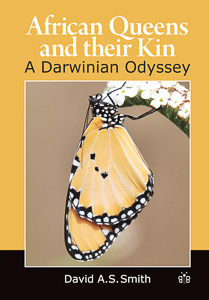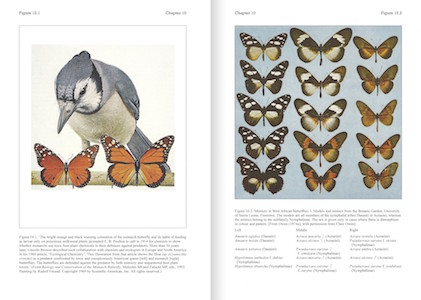 |
| Front Cover |
This book is an amazing compilation of a life's work representing over 40 years of study. Using a model species, the African Queen, Danaus chrysippus, the author takes us on a fascinating tour of the life history, ecology, genetics, behaviour, including mimicry, migration patterns and phylogeography of this important butterfly species complex and its closely related species and forms. It is very much a tour in space - Africa and other tropical countries of the world, as well as North America and Australia - as well as in time, unravelling the evolution of this butterfly in its African home and its slow spread around the globe, time enough for substantial genetic changes to have occurred. Many new and exciting discoveries are included...such as the fact that the butterflies suffer from male-killing endobacteria which greatly bias population sex ratios, to female lekking and lesbianism, cannibalism, rape, fratricide and pederasty.
The book is targeted at academics and dedicated amateurs from around the world with interests in the genetics, behaviour, ecology, ecological chemistry, speciation, parasitism and phylogeography of butterflies, as well as entomology in general.
David A. S. Smith, PhD, FLS, FRES, a world expert on the biology of butterflies and the author of numerous scientific papers about them, was one-time Head of Biology and Curator of the Natural History Museum at Eton College, Berkshire, U.K. Before, during and since this time, he also spent extended periods in Africa, especially at the University of Dar es Salaam in Tanzania, where he studied the extraordinary biology of the African Queen butterfly complex, an iconic group of morphologically similar, but genetically divergent species and sub-specific forms. The present work represents the accumulation of the fruits of his researches, painstakingly gathered over four decades.
This is a vast book, in every sense. In 800 compelling pages and over 40 colour plates the author presents the most complete account of a single species group I have ever read. The star of the book is the African Queen, Danaus chrysippus - a butterfly many know by the much less exotic title, 'Plain Tiger' - but Smith zooms out to examine the whole genus, Danaus, and in, to explore the complex of subspecies and emergent semispecies constituting the taxon chrysippus. Every aspect of the biology, ecology, genetics, behaviour, distribution and evolution of this fascinating group is covered in depth, with full reference to the original research on which the science is based (much of it by the author himself, who has spent over 40 years studying these butterflies). In a refreshing break from contemporary style, Smith does not spare the reader technical terminology or complex arguments but simply lays out the science. For that reason, non-biologists will find the book dense in parts and sometimes rather hard work. In acknowledgement of this there is a complete and very informative glossary, as well as a list of all abbreviations used (particularly useful for non-biochemists, like me). The result is a volume of real substance.
 |
From the beginning, Smith whets the appetite with tantalising questions and uncanny (though entirely coincidental) mythical parallels. In mythology, Danaus married his 50 daughters to the 50 sons of Aegyptus, leading to a nuptial bloodbath on the night of the wedding, when 49 of the sons were slain by their new brides. Eventually, the murderous daughters were remarried and the clan prospered. So too, there are male-killing agents at work in the Lepidopteran daughters of Danaus, leading to all-female families of Queens. Why? Cui bono? You have to wait until chapter 6 to find out ... But this is only one of many riddles and enigmas explored by the book. Why should a species protected by its instantly recognisable unpalatability be polymorphic in East Africa? Surely, for predators to learn by the 'once bitten, twice shy' principle, individuals should look as alike as possible. How do caterpillars and butterflies cope with their own high toxicity? How do mimetic relationships develop? How do sexual and environmental selection pressures govern the colours and patterns of butterflies' wings? How do migrant butterflies navigate? Especially interesting to me were the sections on the origins, intrageneric relations and (pre)historic dispersal of the genus Danaus. It should be pointed out, though, that much of this knowledge comes at a cost - namely the sacrifice of many thousands of butterflies on the altar of science, in experiments I could not countenance doing. Though I regret this and for myself would choose ignorance and awe over knowledge in many instances, it is to the credit of this book that it does not conceal or gloss over the process of science.
The book's subtitle sets the context for all the individual puzzles it unravels: the ongoing evolution of species. Perhaps because Darwinism is feted as a rational, scientific alternative to creationism, it is often thought of as a theory about the past, as if it were merely an account of how things came to be as they are. But it is much more than this: it is an account of how things are becoming what they will be. Evolution is a work in progress, with more time left to run than has already elapsed. The Danaine species we see today, distributed around the world, are like a snapshot, at a moment in history, from a family album. Many millennia hence, different faces will be smiling out from the pages. Those new species are being born in front of our eyes right now, though we can only see it happening by inference and through the painstaking detective work of scientists like David Smith. It is our responsibility to make sure there is still a beautiful world for the descendents of Danaus to emerge into thousands of years from now.
The book can be ordered directly from the publisher, Brambleby Books.